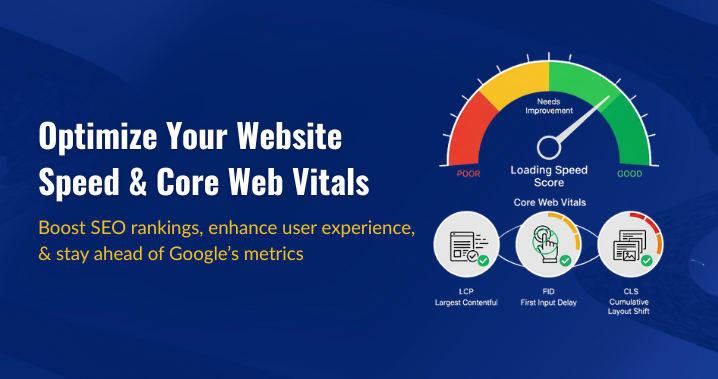
When it comes to ranking on Google, page speed and web vitals are no longer optional—they’re essential. Search engines reward websites that load fast and deliver a smooth user experience, while slow and clunky websites risk losing both visitors and rankings.
As a Toronto SEO expert, Pat’s Marketing often sees businesses overlook this critical factor, even though it directly impacts traffic, conversions, and revenue. To understand why it matters, you also need to see how it connects with the two pillars of SEO: On-Page SEO and Technical SEO.
What Is Page Speed?
Page speed refers to how quickly the content on a specific page loads. It’s different from site speed, which is an average across multiple pages. A fast-loading page keeps visitors engaged, reduces bounce rates, and signals to Google that your website is well-optimized.
In highly competitive markets like Toronto, where users have plenty of choices, even a one-second delay can mean losing potential customers to a faster competitor.
What Are Core Web Vitals?
In 2021, Google introduced Core Web Vitals as part of its page experience update. These are specific performance metrics designed to measure real-world user experience:
- Largest Contentful Paint (LCP): How quickly the main content loads. Good: ≤ 2.5 seconds.
- First Input Delay (FID): How quickly a page responds to user interaction. Good: ≤ 100 ms.
- Cumulative Layout Shift (CLS): How stable your layout is while loading. Good: ≤ 0.1.
In 2024, Google began shifting from FID to Interaction to Next Paint (INP) for more accurate interactivity measurement.
Together, these metrics provide a reliable snapshot of your website’s performance.
Why Page Speed & Web Vitals Matter for SEO?
Google has made it clear: speed and user experience directly influence rankings. But the role of page speed goes beyond technical benchmarks—it also connects deeply to the two SEO pillars:
- On-Page SEO: Elements like fast-loading images, clean code, and well-structured content improve user experience and keep visitors engaged. If your content is great but takes forever to load, users will never see its value.
- Technical SEO: Optimizations like server response times, caching, CDN usage, and Core Web Vitals compliance fall under technical SEO. These ensure that your website is crawlable, efficient, and search-engine-friendly.
When both aspects work together, you get a website that’s not only optimized for Google but also enjoyable for users.
How to Measure Page Speed & Web Vitals
Thankfully, measuring performance isn’t guesswork. Tools like:
- Google PageSpeed Insights
- Lighthouse
- GTmetrix
- Google Search Console’s Core Web Vitals Report
…make it simple to track and identify areas for improvement. Regular monitoring is essential because a website that loads well today might slow down over time as new content, plugins, or scripts are added.
Common Issues Slowing Down Websites
If your site isn’t passing Core Web Vitals, chances are it’s struggling with one or more of these problems:
- Oversized or uncompressed images
- Render-blocking CSS and JavaScript
- Too many plugins or third-party scripts
- Slow server response times
- Lack of caching setup
- Redirect chains or unnecessary code
These issues might sound technical, but they directly affect how users interact with your site.
How to Improve Page Speed and Core Web Vitals
Here are proven ways to improve performance while aligning with On-Page and Technical SEO strategies:
For On-Page SEO:
- Optimize images with alt text and compression.
- Use SEO-friendly, lightweight formatting.
- Ensure content above the fold loads first.
- Maintain clear and stable page layouts to avoid CLS issues.
For Technical SEO:
- Minify CSS, HTML, and JavaScript.
- Implement a Content Delivery Network (CDN).
- Enable browser caching for repeat visits.
- Fix server response delays by upgrading hosting.
- Use lazy loading for media files.
- Keep Core Web Vitals scores within Google’s thresholds.
By combining these improvements, you create a website that’s not only fast but also structurally sound for long-term SEO success.
The Future of Web Vitals
Google is constantly refining what it measures for user experience. Beyond LCP, INP, and CLS, we may see new metrics added to evaluate responsiveness, stability, or usability. Businesses that keep up with these updates will have a clear advantage in maintaining strong search rankings.
Boost Your Rankings with Pat’s Marketing
Mastering page speed and web vitals is no longer just a technical task—it’s a critical part of both on-Page SEO and technical SEO. By improving these areas, your business can achieve higher rankings, reduce bounce rates, and deliver a smoother user experience.
If you’re ready to take your SEO strategy to the next level, partner with a trusted Toronto SEO expert. At Pat’s Marketing, we specialize in optimizing websites for both search engines and users, ensuring you stay ahead of the competition. Call us today at 437-826-9333 to discuss how we can boost your Core Web Vitals and help you dominate search results.
